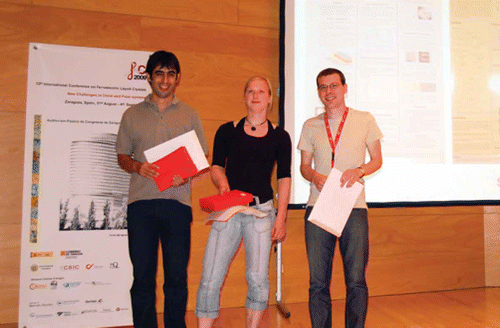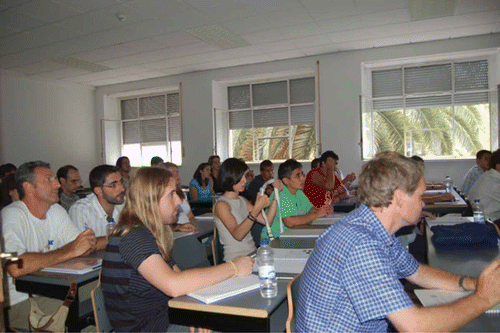12th International Conference on Ferroelectric Liquid Crystals (Zaragoza 2009)
The 12th International Conference on Ferroelectric Liquid Crystals (FLC 09) was held in Zaragoza (Spain) from 31 August to 4 September 2009. It continued the tradition of the 11 former FLC conferences in offering a detailed overview of the current research and applications of ferroelectric mesogens. The subtitle of the Conference chosen by the Organising Committee, ‘New Challenges in Chiral and Polar Systems’, aimed to broaden the scope of the meeting, incorporating topics not strictly within the fields of liquid crystals and ferroelectricity, but trying to attract new specialists from related areas. The Conference was attended by 150 delegates from 18 countries.
Continuing the practice established in the previous meetings, tutorials on different subjects were offered during the whole first day. Professors David Walba, Antal Jákli, Claudio Zannoni, Philippe Barois and Masanori Ozaki gave 50 minute lectures on chemistry, physics, computer simulation, X-ray diffraction and photonics, respectively, offering basic but original views on the application of these topics to chiral and polar liquid crystalline systems. A broad audience of more than 30 people, not only composed of young students, took part in this activity ().
The conference itself started on the morning of 1 September and finished at noon on Friday, 4 September. As usual, both oral and poster sessions formed part of the conference. The oral program consisted of 11 invited talks, each of them 30 minutes long, and 37 short talks of 20 minutes each, which included a 5 minute discussion time. There were 90 poster communications, all under permanent display over the three days, although the discussions were mainly concentrated in two afternoon sessions. Awards to the three best poster contributions, sponsored by the Royal Society of Chemistry, were given at the end of the meeting ().
Figure 2. Winners of the best poster awards. From left to right, C. Sánchez, K. Geese and P.D. Brimicombe.

The oral contributions were divided according to five different topics: new materials, chiral systems, bent-core molecules, ferroelectric mesophases and technology. There were several talks that deserve special comment. N.A. Clark opened the conference introducing the subject of polarisation elasticity. T. Hegmann and R. Dabrowski gave remarkable talks about some new possibilities for novel materials. Bent-core based materials were covered through different talks. Noticeable were the contributions by C. Tschierske about the biaxial character of nematic phases of banana molecules and by A. Jákli about the flexoelectricity in those materials, both of which gave rise to lively discussions among the participants. Other communications about bent-core mesogens, such as those given by H. Takezoe on giant optical activity and A. Eremin on unusual switching responses, should also be highlighted. C.L. Folcia presented a comprehensive review on the possibilities of ferroelectric mesogens in the field of nonlinear optics. P. Rudquist showed new results in the de Vries smectic A phases and H.S. Kitzerow presented new challenges in blue phases. Finally, eight talks, two of them invited, dealt with the area of technological applications. Here we mention the invited contribution of C. Bastiaansen who reported on the use of chiral nematics in security and sensors.
We keep Zaragoza in good memory, remembering a city not only suitable for science and as the site of several research centres (University of Zaragoza, Instituto de Ciencia de Materiales de Aragón (ICMA), Instituto de Biocomputación y Física de Sistemas Complejos (BIFI), Instituto de Nanociencia de Aragón (INA), or Instituto de Investigación e Ingeniería de Aragón (I3A)), but also for culture in general, or just for having a good time. It is easy to understand that a city which has been at the crossroads of different civilisations for more than 2000 years must necessarily be able to offer a huge cultural heritage, but, at the same time, the people of Zaragoza know how to enjoy themselves, as any of the Conference participants could verify just by walking along the streets of Zaragoza Old Town.
The next FLC Conference (FLC 11) will take place at Niagara Falls (Canada) in August–September of 2011, thus continuing a non-written tradition according to which FLC conferences are held in North America every 10 years. This time it will be organised by Professors R.P. Lemieux (Queen's University, Ontario, Canada), A. Jákli (Kent State University, Ohio, USA) and C. Rosenblatt (Case Western Reserve University, Ohio, USA). We wish them the best of luck.
We could not conclude this report without acknowledging the local Organising Committee for the perfect organisation of the event. Everything happened as had been planned in advance and always on time. Special thanks should be given to M. Blanca Ros, Chair of the conference, and also to all the members of the Liquid Crystal and Polymer Group of Zaragoza. We owe them in great part for the success of the meeting.
